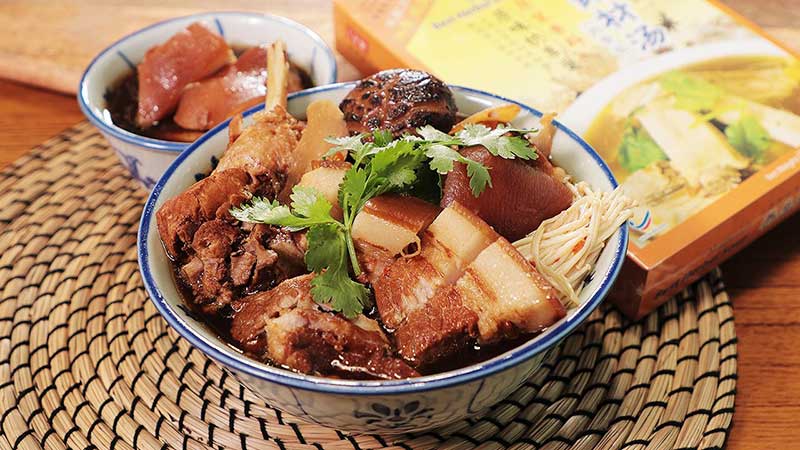Bak Kut Teh, a popular dish in Southeast Asia, is a flavorful and aromatic soup made with pork ribs and a blend of Chinese herbs and spices. This dish has a rich history that dates back several centuries, originating in Southern China and spreading its influence throughout the region. In this article, themanestreet will delve into the fascinating history of Bak Kut Teh, exploring its origins, cultural significance, and evolution over time.
Origins of Bak Kut Teh
Bak Kut Teh finds its origins in Southern China, particularly the Fujian province. The dish was traditionally consumed by laborers and coolies who sought nourishment and energy after long hours of work. Its name, which translates to “meat bone tea,” reflects the cooking method of simmering pork ribs and spices in a flavorful broth.
The Legend of Bak Kut Teh’s Creation
According to popular folklore, Bak Kut Teh was invented by a Chinese herbalist who sought to create a tonic to alleviate various ailments. This herbalist combined various medicinal herbs and spices with pork bones, simmering them for hours. The resulting concoction became known as Bak Kut Teh and was believed to possess restorative properties.
Migration and Spread of Bak Kut Teh
During the 19th and 20th centuries, many Chinese immigrants brought Bak Kut Teh to different parts of the world, including Malaysia, Singapore, and Indonesia. As these immigrants settled in new lands, they adapted the recipe to suit local tastes and ingredients, resulting in regional variations of the dish.

Variations of Bak Kut Teh
The migration and regional influences have led to the development of several Bak Kut Teh variations. For example, the Hokkien-style Bak Kut Teh is characterized by a robust herbal flavor, while the Teochew-style version features a lighter and peppery broth. Each variation carries its own distinct taste and culinary heritage.
Bak Kut Teh in Modern Times
In recent years, Bak Kut Teh has gained immense popularity, not only in Southeast Asia but also in other parts of the world. It has become a beloved dish among locals and tourists alike, thanks to its unique flavors and cultural significance. Many restaurants and food establishments specialize in serving this hearty delicacy.
Health Benefits of Bak Kut Teh
Aside from its delightful taste, Bak Kut Teh offers various health benefits. The herbal components of the dish are believed to possess medicinal properties that can aid digestion, boost the immune system, and improve blood circulation. However, it is important to consume Bak Kut Teh in moderation as part of a balanced diet.
Cooking Techniques and Ingredients
The preparation of Bak Kut Teh requires meticulous attention to detail. The cooking process involves simmering pork ribs with a mix of herbs and spices, such as star anise, cloves, cinnamon, and garlic. The slow and gradual infusion of flavors creates a broth that is both fragrant and nourishing.

The Perfect Accompaniments to Bak Kut Teh
Traditionally, Bak Kut Teh is served with various accompaniments to enhance the dining experience. These may include youtiao (Chinese fried dough), rice, sliced chili, and soy sauce. The combination of tender pork ribs, flavorful broth, and complementary side dishes creates a harmonious symphony of tastes.
The Cultural Significance of Bak Kut Teh
Bak Kut Teh holds significant cultural value in the communities where it is enjoyed. It is often shared among family and friends, fostering a sense of togetherness and bonding. The act of savoring this dish reflects the importance of communal dining and the appreciation of culinary heritage.
Bak Kut Teh Around the World
As Bak Kut Teh gained popularity, it spread beyond Southeast Asia to various parts of the world. Today, you can find Bak Kut Teh establishments in countries like the United States, Australia, and even Europe. Its global presence is a testament to its appeal and the multicultural nature of contemporary cuisine.
Bak Kut Teh: A Culinary Experience
Enjoying a bowl of Bak Kut Teh is not just about satisfying hunger; it is a culinary experience. The combination of tender meat, aromatic broth, and medicinal herbs creates a delightful harmony of flavors. It is a dish that stimulates the senses and leaves a lasting impression on those who indulge in its goodness.
Stage Play Audition Success: Insider Tips and Strategies for Standing Out
Preserving the Tradition of Bak Kut Teh
Amidst the evolving culinary landscape, efforts are being made to preserve the tradition of Bak Kut Teh. Various organizations and passionate individuals strive to ensure that the authentic flavors and cultural significance of this dish are passed down to future generations. These endeavors contribute to the preservation of culinary heritage and cultural identity.
Bak Kut Teh Recipes: Traditional and Contemporary
For those who wish to embark on a culinary adventure, there are numerous Bak Kut Teh recipes available. These recipes range from traditional renditions that stay true to the dish’s origins to contemporary interpretations that incorporate innovative twists. Exploring these recipes allows individuals to appreciate the versatility and adaptability of Bak Kut Teh.
Exploring Bak Kut Teh Establishments
If you find yourself craving Bak Kut Teh, there are plenty of establishments where you can indulge in this delectable dish. From humble roadside stalls to upscale restaurants, you can find a diverse range of options that cater to different preferences and budgets. Exploring these establishments provides an opportunity to delve deeper into the world of Bak Kut Teh.
Conclusion
Bak Kut Teh, with its rich history and tantalizing flavors, continues to captivate food enthusiasts around the world. From its humble beginnings in Southern China to its widespread popularity today, this dish represents the intersection of culture, culinary traditions, and shared experiences. So, the next time you have a chance to savor a bowl of Bak Kut Teh, relish in the depth of its flavors and appreciate the fascinating journey it has undertaken.
FAQs (Frequently Asked Questions)
Can I make Bak Kut Teh without pork?
While pork is the traditional choice for Bak Kut Teh, some recipes offer alternatives for those who prefer other meats or vegetarian options. These variations may use chicken, mushrooms, or tofu as substitutes for pork.
Is Bak Kut Teh spicy?
The level of spiciness in Bak Kut Teh varies depending on the regional variation and personal preferences. Some versions, like the Teochew-style Bak Kut Teh, have a peppery kick, while others may be milder or have a more herbal tasteto them.
Can I freeze leftover Bak Kut Teh?
Yes, you can freeze leftover Bak Kut Teh for future consumption. It is recommended to store it in an airtight container or freezer bag to maintain its flavor and quality. When reheating, thaw it in the refrigerator overnight and gently heat it on the stovetop.
What are some common herbs and spices used in Bak Kut Teh?
Some common herbs and spices used in Bak Kut Teh include star anise, cloves, cinnamon, garlic, dang gui (Chinese angelica root), and dang shen (codonopsis root). These ingredients contribute to the distinctive aroma and taste of the broth.
Is Bak Kut Teh a complete meal by itself?
Bak Kut Teh is a flavorful and filling dish on its own, but it is often accompanied by rice, youtiao (Chinese fried dough), and other side dishes to create a more substantial meal. The combination of these components makes for a satisfying dining experience.











